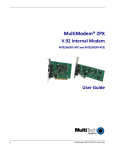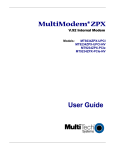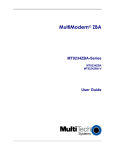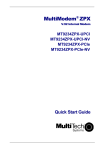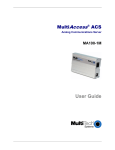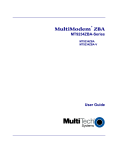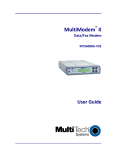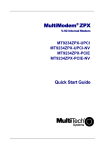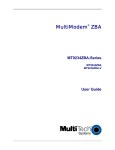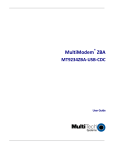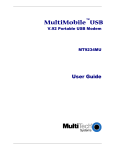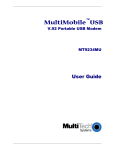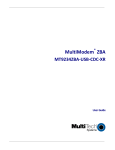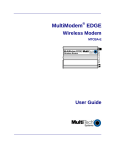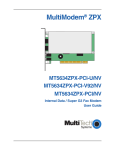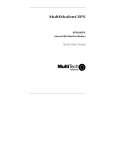Download Multitech MT9234ZPX-UPCI User guide
Transcript
MultiModem® ZPX V.92 Internal Modem MT9234ZPX-UPCI MT9234ZPX-UPCI-NV MT9234ZPX-PCIE MT9234ZPX-PCIE-NV User Guide MultiModem ZPX User Guide MT9234ZPX-UPCI MT9234ZPX-UPCI-NV MT9234ZPX-PCIE MT9234ZPX-PCIE-NV P/N S000414A, Revision A All rights reserved. This publication may not be reproduced, in whole or in part, without prior expressed written permission from Multi-Tech Systems, Inc. Copyright © 2008-2009 by Multi-Tech Systems, Inc. Multi-Tech Systems, Inc. makes no representation or warranties with respect to the contents hereof and specifically disclaims any implied warranties of merchantability or fitness for any particular purpose. Furthermore, Multi-Tech Systems, Inc. reserves the right to revise this publication and to make changes from time to time in the content hereof without obligation of Multi-Tech Systems, Inc., to notify any person or organization of such revisions or changes. Check Multi-Tech’s Web site for current versions of our product documentation. Revision Revision A Date 01/16/08 05/04/09 Description Initial Release. Added a link to the Multi-Tech Web site for the Multi-Tech warranty and repairs policy. Trademarks MultiModem, Multi-Tech, and the Multi-Tech logo are trademarks of Multi-Tech Systems, Inc. Microsoft, Windows 2000, 2003, XP, and Vista are registered trademarks or trademarks of Microsoft Corporation in the United States and/or other countries. Warranty For Warranty information, see the Multi-Tech Web site at http://www.multitech.com Patents This device covered by one or more of the following patents: 6,031,867; 6,012,113; 6,009,082; 5,905,794; 5,864,560; 5,815,567; 5,815,503; 5,812,534; 5,809,068; 5,790,532; 5,764,628; 5,764,627; 5,754,589; 5,724,356; 5,673,268; 5,673,257; 5,644,594; 5,628,030; 5,619,508; 5,617,423; 5,600,649; 5,592,586; 5,577,041; 5,574,725; 5,559,793; 5,546,448; 5,546,395; 5,535,204; 5,500,859; 5,471,470; 5,463,616; 5,453,986; 5,452,289; 5,450,425; D353, 598; 5,355,365; 5,309,562; 5,301,274; 7082106;7082141;7092406. Other Patents Pending World Headquarters Multi-Tech Systems, Inc. 2205 Woodale Drive Mounds View, Minnesota 55112 Phone: 763-785-3500 or 800-328-9717 Fax: 763-785-9874 Technical Support Country Europe, Middle East, Africa: U.S., Canada, all others: By Email [email protected] [email protected] By Phone +(44) 118 959 7774 (800) 972-2439 or (763) 717-5863 Internet Address: http://www.multitech.com 2 Multi-Tech Systems, Inc. MT9234ZPX User Guide Contents Contents CHAPTER 1: DESCRIPTION AND SPECIFICATIONS 5 Product Description Features AT Command Info Package Contents Technical Specifications 5 5 6 6 6 CHAPTER 2: INSTALLATION 8 General Safety Install your MultiModem Make the External Connections Line Connection Phone Connection (Optional) Microphone/Headphone Connection (Optional) Sound Card and Speaker Connections (If you have the Voice Option) Installing the Modem Driver Vista Operating System Preliminaries Driver Installation of your PCI Serial Port Installation of the Communications Port Installation of the Modem Driver Installation Windows XP/2003/2000 Preliminaries Installation of the Single-port UART PCI Card Installation of the Communications Port Installation of the Modem Configure the Modem for Your Country or Region Using the Global Wizard to Configure Your Modem Using AT Commands to Configure Your Modem 8 8 9 9 9 9 9 10 10 10 10 12 13 15 15 15 16 17 18 18 18 CHAPTER 3: REMOTE CONFIGURATION 19 Basic Procedure Setup To Change the Setup Password To Change the Remote Escape Character 19 19 19 20 CHAPTER 4: TROUBLESHOOTING 21 The Modem Does Not Respond to Commands The Modem Cannot Connect When Dialing The Modem Disconnects While Online The Modem Cannot Connect When Answering File Transfer Is Slower Than It Should Be Data Is Being Lost There Are Garbage Characters on the Monitor The Modem Doesn’t Work with Caller ID Fax and Data Software Can’t Run at the Same Time The Voice Functions Don’t Work Voice Mail Test Loopback Test Speakerphone Test (with voice option) 21 22 23 23 23 24 24 24 24 24 24 25 25 APPENDIX A: WASTE ELECTRICAL AND ELECTRONIC EQUIPMENT (WEEE) STATEMENT 26 APPENDIX B – REGULATORY COMPLIANCE 27 FCC Part 68 Telecom FCC Part 15 27 28 Multi-Tech Systems, Inc. MT9234ZPX User Guide 3 Contents Canadian Limitations Notice Industry Canada Protection Against Contact with TNV Circuit EMC, Safety, and R&TTE Directive Compliance New Zealand Telecom Warning Notice South African Notice International Modem Restrictions 28 28 29 29 29 30 30 APPENDIX C – UPGRADING YOUR MODEM 31 Introduction Upgrade Overview Step 1: Identify the Modem Firmware Step 2: Identify the Current Firmware Version Step 3: Download the Upgrade File Step 4: Extract the Upgrade Files Step 5: Document and Clear Your Stored Paramenters Step 6: Upgrade the Modem’s Firmware Step 7: Restore Your Parameters 31 31 31 31 32 32 32 32 33 APPENDIX D – INSTALLING UNDER LINUX 34 Introduction Using AT Commands to Configure Country Code 34 37 APPENDIX E: C-ROHS HT/TS SUBSTANCE CONCENTRATION 38 INDEX 39 4 Multi-Tech Systems, Inc. MT9234ZPX User Guide Chapter 1 - Description and Specifications Chapter 1: Description and Specifications Product Description The Multi-Tech MultiModem ZPX is an internal universal PCI bus card, MT9234ZPX-UPCI or a PCI Express bus card, MT9234ZPX-PCIE. The UPCI card operates in either 3.3 or 5V slot. The PCI Express card operates in a 3.3V slot. The MultiModem provides high-speed data transfer and fax capabilities for small businesses, telecommuters, and SOHO users. It is compatible with the IUT-T V.92 protocol that provides quick connections, downstream transmissions at speeds up to 56K bps*, and upstream transmissions speeds up to 48K bps when connected to V.92-compatible Internet service providers. Transmissions between the MultiModem and other client modems are limited to 33.6K bps, as are upstream transmissions to non-V.92-compatible ISPs and downstream transmissions that are converted more than once on the telephone network. MT9234ZPX-UPCI MT9234ZPX-PCIE Features • • • • • • • • • • • • • • V.92/56K download speeds and 48K upload speeds when connecting with V.92 servers V.44 compression improves data throughput rates Class 1.0 and Class 2.1 faxing at speeds to V.34/33.6K bps (Super G3) Error Correction Mode (ECM) provides fast and reliable fax transmissions Voice support for voice mail and full duplex speakerphone (voice models only) Compatible with Windows® Vista, XP, 2003, 2000, and Linux U.S. Caller ID reporting Global approvals in many countries for worldwide use Telco adapters available for country localization Built-in processor that does the work, so your computer doesn’t have to Remote configuration for centralized setup and management DTMF tone detection Flash memory for easy updates Two-year warranty NOTE: * Though this modem is capable of 56K bps download performance, line impairments, public telephone infrastructure, and other external technological factors currently prevent maximum 56K bps connections. Multi-Tech Systems, Inc. MT9234ZPX User Guide 5 Chapter 1 - Description and Specifications AT Command Info AT commands for the wireless modem are published in a separate Reference Guide included on the product CD and posted on the Multi-Tech web site. Package Contents • • • • • one MultiModem one RJ-11 telephone cable one Quick Start Guide one product CD One low profile mounting bracket (MT9234ZPX-PCIE models only) Technical Specifications The MultiModem meets the following specifications: Category Server-to-Client Data Rates Client-to-Server Data Rates Receiver AGC Dynamic Range Client-to-Client Data Rates Data Compatibility Data Format Error Correction (ECM) Data Compression Fax Compatibility Fax Classes Fax Data Rates Fax Compression Command Buffer DAA Isolation Dimensions Flow Control Frequency Stability Modes of Operation Operational Temperature Range Storage Temperature Power Requirements Voice Compatibility 6 Description 56K speeds when accessing a V.92 server (actual speed depends on server capabilities and line conditions)* Up to 48Kbps when accessing a V.92 server (actual speed depends on server capabilities and line conditions); otherwise the same as client-to-client data rates. 43 dB 33,600; 31,200; 28,800; 26,400; 24,000; 21,600; 19,200; 16,800; 14,400; 12,000; 9600; 7200; 4800; 2400; 1200; 0-300 bps V.92, V.34 enhanced, V.34, V.32bis, V.32, V.22bis, V.22; Bell 212A and 103/113, V.21 & V.23 Serial, binary, asynchronous Data Mode V.44; V.42 LAPM, MNP 2-4 Fax Mode T.30 Annex A & C V.42bis & MNP Class 5 V.34, V.17, V.29, V.27, & V.21 Ch. 2 Class 1 &1.0 and Class 2, 2.0 &2.1 33,600; 31,200; 28,800; 26,400; 24,000; 21,600; 19,200; 16,800; 14,400; 12,000; 9600; 7200; 4800; 2400; 1200; 0-300 bps MH, MR, MMR 80 characters 1500 Vac UPCI – 6.03” L X 4.76” W 15.31 cm L x 12.09 cm W PCIE with Standard Bracket – 7.13” L x 4.76” W 18.11 cm L x 12.09 cm W PCIE with Low Profile Bracket – 7.13” L x 3.16” W 18.11 cm L x 8.02 cm W XON/XOFF (software), RTS/CTS (hardware) ±0.01% Fax online mode; full duplex over dial-up lines; data mode; command mode; online command mode; V.54 test mode -5 to+60° C (23° to 140°F) humidity range 20–90% (noncondensing) –40 to +85°C (-40° to 185° F) 3.3 or 5 volt slot (Universal PCI) 3.3 volts (PCI Express) TAM (Telephone Answering Machine): S-101 AT+V commands (no CODEC for speakers/microphone interface) Multi-Tech Systems, Inc. MT9234ZPX User Guide Chapter 1 - Description and Specifications Category Serial Speeds Transmit Level Receiver Sensitivity Cleaning Manufacturing Information Approvals Intelligent Features Description Serial port data rates adjustable to 300, 1200, 2400, 4800, 9600, 19,200, 38,400, 57,600, 115,200, and 230,400 bps –11 dBm (varies by country setting) –43 dBm under worst-case conditions No cleaning/washing due to the manufacturing process used to produce this product. Trade Name: MultiModem®ZPX Model Number: MT9234ZPX Registration No: AU7MM01BMT9234SMI Ringer Equivalence: 0.1B Modular Jack (USOC): RJ11 CE Mark Telecom 47CFR Part 68 CS03 TBR21 Safety Certifications UL/cUL 60950-1 EN60950-1 AS/NZS 60950:2000 CCC EMC Approvals FCC Part 15, Class B ICES-003, Class B EN 55022, Class B EN 55024 Fully AT command compatible Sleep mode Autodial, redial Pulse or tone dial Dial pauses Auto answer Adaptive line probing Automatic symbol and carrier frequency during start-up, retrain, and rate renegotiations DTMF detection Distinctive ring Voice record and playback Call status display, auto-parity and data rate selections Keyboard-controlled modem options On-screen displays for modem option parameters Remote configuration Phone number storage Flash memory for firmware updates NVRAM storage for user-defined parameters Multi-Tech Systems, Inc. MT9234ZPX User Guide 7 Chapter 2 - Installation Chapter 2: Installation General Safety • • • • • • • • • Use this product only with UL- and CUL-listed computers (U.S.A.) To reduce the risk of fire, use only UL-listed 26 AWG (.41mm) or larger telephone wiring. Never install telephone wiring during a lightning storm. Never install a telephone jack in a wet location unless the jack is specifically designed for wet locations. Never touch uninsulated telephone wires or terminals unless the telephone line has been disconnected at the network interface. Use caution when installing or modifying telephone lines. Avoid using a telephone during an electrical storm; there is a risk of electrical shock from lightning. Do not use a telephone in the vicinity of a gas leak. The telephone cord is to be disconnected before accessing the inside of the equipment. Install your MultiModem Installing the MultiModem requires you to open your system. Please consult your system manual in addition to the following instructions. MT9234ZPX-UPCI MT9234ZPX-PCIE 1. Turn off your system and unplug it. Failure to do so may result in damage to both the MultiModem and your system. Do not turn on the system until the instructions tell you to do so. 2. Remove the cover from your system as instructed in the system manual. 3. If you are installing a MT9234ZPX-PCIE board in a low profile machine, you will need to change the mounting bracket to the low profile mounting bracket. 4. Select an empty PCI expansion slot. Remove the expansion slot cover and save the retaining screw. 8 Multi-Tech Systems, Inc. MT9234ZPX User Guide Chapter 2 - Installation 5. Before handling the MultiModem, discharge static in your body by touching a piece of bare metal on the chassis. Carefully remove the MultiModem from its antistatic bag, handling it only by the mounting bracket and edges. Do not touch the gold-plated connectors along the bottom edge. 6. Look at the system’s main board to determine either PCI or Express connector. Place the MultiModem directly above the expansion slot and gently, but firmly, push it into the connector until the card’s retaining bracket is flush against the system chassis. 8. Fasten the retaining bracket to the system chassis with the screw saved in step 4. 9. Replace the system cover. Make the External Connections Now connect the MultiModem to the telephone line and, optionally, to your telephone. For voice mail or speakerphone use, you can also connect it to a microphone and an external speaker, headphone, or sound card. The microphone can be used for recording answering machine messages or for speakerphone use. The speaker or headphone can be used for playing back messages or as a speakerphone. PHONE PH ONE LINE L INE MIC IN Optional Voice MIC LINE OUT L INE Line Connection Plug one end of the provided telephone cable into the modem’s LINE jack, and the other end into a telephone wall jack. This is the only required connection. Note: The LINE jack is not interchangeable with the PHONE jack. Do not plug the phone into the LINE jack or the line cable into the PHONE jack. Note: The Federal Communications Commission (FCC) and Industry Canada impose certain restrictions on equipment connected to public telephone systems. Phone Connection (Optional) If you wish to connect a telephone to the same line as the modem, plug it into the modem’s PHONE jack. Note: The PHONE jack is not interchangeable with the LINE jack. Do not plug the phone into the LINE jack or the line cable into the PHONE jack. Microphone/Headphone Connection (Optional) For voice mail or speakerphone applications, plug an unamplified microphone into the MIC jack. The microphone and headphone should have a stereo 3.58mm (9/64-inch) mini plug. Do not use a monophonic microphone. Sound Card and Speaker Connections (If you have the Voice Option) For voice mail or speakerphone applications, use a 3.58mm (9/64-inch) plug male-to-male stereo patch cord to connect the LINE OUT jack on the modem to the LINE IN jack on your sound card. If your sound card does not have a LINE IN jack, use its MIC jack. This will allow you to hear modem activity whether it is originating or answering a call, or playing a recorded message. If you do not have a sound card, you can plug an amplified speaker into the LINE OUT jack. Multi-Tech Systems, Inc. MT9234ZPX User Guide 9 Chapter 2 - Installation Installing the Modem Driver The MT9234ZPX drivers need to be installed in your computer’s program directory. The procedure will be different depending on the operating system. The first section provides installation for the Vista Operating System. The second section provides installation for Windows 2000 thru Windows XP Operating Systems. If you use a Linux operating system, please refer to Appendix D in the User Guide for installation instructions. Vista Operating System The MT9234ZPX driver installation is done in three parts, each directed by an installation wizard. The three parts are: (1) installation of your PCI Serial Port, (2) installation of the Communications Port, and (3) installation of the modem. Preliminaries 1. Power up your computer. 2. Windows will detect that the new modem is present. Driver Installation of your PCI Serial Port 3. The Found New Hardware screen appears with Windows needs to install driver software for your PCI Serial Port. Click on Locate and install driver software (recommended). Windows will guide you through the process of installing driver software for your device. 4. The next screen prompts you to insert the disc that came with your PCI Serial Port. If you have the disc that came with your device, insert it now. Windows will automatically search the disc for driver software. Click Next. 10 Multi-Tech Systems, Inc. MT9234ZPX User Guide Chapter 2 - Installation 5. Windows couldn’t find driver software for your device screen appears. Choose Browse my computer for driver software (advanced). 6. At the Browse for driver software on your computer screen, click the Browse button. 7. Select the Drivers folder, and then the Vista folder on the product CD. Click Next. 8. Searching D:\Drivers\Vista for software… screen appears. 9. When the software for this device has been successfully installed screen appears with Windows has finished installing the driver software for this device: Multi-Tech’s 1-Port PCI Analog Modem Card. Click Close. Multi-Tech Systems, Inc. MT9234ZPX User Guide 11 Chapter 2 - Installation Installation of the Communications Port 10. The Found New Hardware – Multifunction Device screen appears with Insert the disc that came with your Multifunction Device. The MT9234ZPX-PCI product CD is still in the CDROM drive. Click Next. 11. At the Windows couldn’t find driver software for your device, click on Browse my computer for driver software (advanced). Locate and install driver software manually. 12. At the Browse for driver software on your computer screen, click the Browse button and select the Drivers folder, then the Vista folder on the product CD. 13. Click Next. 14. Installing driver software… activity screen appears. 15. Windows can’t verify the publisher of this driver software screen appears. Select Install this driver software anyway. 16. Installing driver software progress screen appears. 12 Multi-Tech Systems, Inc. MT9234ZPX User Guide Chapter 2 - Installation 17. The software for this device has ben successfully installed screen appears with Windows has finished installing the driver software for this device: Multi-Tech Communications Port. Click Close. Installation of the Modem 18. The Found New Hardware – MultiTech Systems MT9234ZPX-PCIE screen appears with Insert the disc that came with your MultiTech Systems MT9234ZPX-PCIE. The MT9234ZPX-PCI product CD is still in the CDROM drive. Click Next. 19. At the Windows couldn’t find driver software for your device, click on Browse my computer for driver software (advanced). Locate and install driver software manually. 20. At the Browse for driver software on your computer screen, click the Browse button and select the Drivers folder, then the Vista folder on the product CD. 21. Click Next. Multi-Tech Systems, Inc. MT9234ZPX User Guide 13 Chapter 2 - Installation 22. Windows can’t verify the publisher of this driver software screen appears. Select Install this driver software anyway. 23. Installing driver software progress screen appears. 24. The software for this device has ben successfully installed screen appears with Windows has finished installing the driver software for this device: Multi-Tech Systems MT9234ZPX-PCIE. 25. Click Close. The installation of drivers is now complete. 14 Multi-Tech Systems, Inc. MT9234ZPX User Guide Chapter 2 - Installation Driver Installation Windows XP/2003/2000 The MT9234ZPX driver installation is done in three parts, each directed by an installation wizard. The three parts are: (1) installation of the Single-port UART PCI Card, (2) installation of the Communications Port, and (3) installation of the modem. Preliminaries 1. Power up your computer. 2. Windows will detect that the new modem is present. Installation of the Single-port UART PCI Card The wizard will install the files for the 1-port UART PCI Card. 3. The Welcome to the Found New Hardware Wizard screen appears. In response to the question, “Can Windows connect to Windows Update to search for software?” select “No, not this time” and click Next. 4. The next screen prompts you to insert the product CD into the computer. Insert the product CD, select “Install from a list or specific location (Advanced)”. Click Next. 5. At the Please Choose Your Search and Installation Options screen, select Search for the best driver in these locations and browse on the product CD to the Drivers folder. Select the relevent processor/operating system, AMD64, IA64, or X86. Click OK and click Next. 6. A has not passed Windows logo testing screen appears. Click Continue Anyway. Note: This Microsoft operating system searches for a digital signature when you install any new hardware. If a “has not passed Windows logo testing” screen (or Digital Signature Not Found screen) appears, simply click Continue Anyway (or YES) to continue installation. Although MultiTech submits all eligible products to Microsoft for certification, the turn-around time is subject to many factors. Not having a digital signature does not affect product performance in any way. 7. A Completing the Found New Hardware Wizard screen will appear. This wizard helps you install software for: Multi-Tech’s 1-port UART PCI Card. Click Finish. Multi-Tech Systems, Inc. MT9234ZPX User Guide 15 Chapter 2 - Installation Installation of the Communications Port The wizard will install the files for the Multi-Tech Communications Port. 8. The Welcome to the Found New Hardware Wizard screen appears. This wizard helps you install software for: Multifunction Device. Select Install from a list or specific location (Advanced). Click Next. 9. At the Please Choose Your Search and Installation Options screen, select Search for the best driver in these locations and browse on the product CD to the Drivers folder. Select the relevent processor, AMD64, IA64, or X86. Click OK and click Next. 10. A has not passed Windows logo testing screen appears. Click Continue Anyway. (See note on logo testing above.) 11. A Completing the Found New Hardware Wizard screen will appear. This wizard has finished installing the software for: Multi-Tech Systems MT9234ZPX-UPCI. Click Finish. 16 Multi-Tech Systems, Inc. MT9234ZPX User Guide Chapter 2 - Installation Installation of the Modem The wizard will install the file for Multi-Tech Systems MT9234ZPX Models. 12. The Welcome to the Found New Hardware Wizard screen appears for a third time. This wizard helps you install the software for: MultiTech Systems MT9234ZPX-UPCI. Select Install from a list or specific location (Advanced). Click Next. 13. At the Please Choose Your Search and Installation Options screen, select Search for the best driver in these locations and browse on the product CD to the Drivers folder I multitech_pcie_upci_zpx. 14. A Completing the Found New Hardware Wizard screen will appear with The wizard has finished installing the software for: Multi-Tech systems MT9234ZPX-UPCI. Click Finish. The installation of drivers is now complete. Multi-Tech Systems, Inc. MT9234ZPX User Guide 17 Chapter 2 - Installation Configure the Modem for Your Country or Region Different countries have different requirements for how modems must function. Therefore, before you use your modem, you must configure it to match the defaults of the country/region in which you are using it. You must also do this if you move the modem to another country/region after it has been configured for the first country/region. The modem is set to country, Euro/NAM, with a country code of 52 decimal by default. You can use one of two configuration methods: • Use the Global Wizard to Configure Your Modem • Use AT Commands to Configure Your Modem Using the Global Wizard to Configure Your Modem The Global Wizard configuration utility is recommended for computers running Windows 2000 or newer. 1. Insert the MultiModem product CD into the CD-ROM drive. 2. When the splash screen appears, click on Initial Setup & Country Sel button. 3. The Global Wizard page appears, choose either: • 4. 5. 6. 7. 8. Run Global Wizard from CD. This will not load the wizard onto your hard drive, or • Install Global Wizard on the HD. This will install the wizard onto your hard drive for future use. The Global Wizard dialog box appeared. Click Next. The Global Wizard searches for your modem and identifies it. Click Next. Select the country/region in which the modem will be used. Click Next. Review your country/region choice. If it is correct, click Next to configure the modem. When Global Wizard announces that the parameters have been set, click Finish to exit. Using AT Commands to Configure Your Modem Non-Windows users can configure the modem using AT commands. You must enter these commands in your communication program terminal window. 1. Run your favorite communication program and open the windows terminal window. 2. To configure the modem for a specific country/region, type AT%T19,0,nn, where nn is the country/region code in hexadecimal format, click ENTER. The message OK displays. 3. To verify the change, type ATI9 and click ENTER. The country code is displayed in decimal format, as in this example: Country/Region AT Command (hexadecimal) Country code (decimal) Euro/NAM AT%T19,0,34 (default) 52 A complete list of country/region codes can be found on the Multi-Tech Web site at: http://www.multitech.com/PRODUCTS/Categories/Modems/global/configuration.asp#chart Then click on global modems. The Global Modem Country Approvals page displays. On this page you can view approvals, configuration strings and responses by country and product. 18 Multi-Tech Systems, Inc. MT9234ZPX User Guide Chapter 3 – Remote Configuration Chapter 3: Remote Configuration Remote configuration is a network management tool that allows you to configure the MultiModem anywhere in your network from one location. With password-protected remote configuration, you can issue AT commands to a remote modem for maintenance or troubleshooting as if you were on site. Basic Procedure The following steps are valid regardless of whether the connection is established by the local or the remote Multi-Tech modem. Note: For this procedure, the remote computer must be running, and a communication program must be ready for a data connection. 1. Establish a data connection with a remote MultiModem. 2. Send three remote configuration escape characters followed by AT and the setup password, and press ENTER. Example: %%%ATMTSMODEM (all capital letters). You have four tries to enter the correct password before being disconnected. If the password is correct, the remote modem responds with OK. 3. Type AT commands to configure the remote modem. 4. When you have finished configuring the remote modem, save the new configuration by typing AT&W0 and pressing ENTER. 5. Type ATO and press ENTER to exit remote configuration. You can now break the connection in the normal way. Setup Multi-Tech modems are shipped with a default setup password (MTSMODEM). Because anyone who has the User Guide knows the default setup password, you should change the password and possibly also the remote configuration escape character. Record your changes for future use. To Change the Setup Password 1. Open a data communications program such as HyperTerminal. 2. To change the password, type AT#S=xxxxxxxx, where xxxxxxxx stands for the password, and then press ENTER. The password can include any keyboard character, and can be up to eight characters long. The modem responds with OK. CAUTION: Passwords are case-sensitive. The next time you enter the password, it must be in the same case as you set it up. 3. The new password is saved automatically. You can now either enter more AT commands or exit the data communications program. The next time you wish to set up the modem, you must use the new password. Multi-Tech Systems, Inc. MT9234ZPX User Guide 19 Chapter 3 - Remote Configuration To Change the Remote Escape Character To further improve security, you can change a remote modem’s remote configuration escape character either locally or remotely. The remote configuration escape character is stored in register S9. The factory default is 37, which is the ASCII code for the percent character (%). Setting S9 to 0 (zero) disables remote configuration entirely. CAUTION: If you set S9 to 0 (zero) remotely, you won’t be able to change it back remotely. 1. Establish a remote configuration link with the remote modem as described in “Basic Procedure.” 2. Type ATS9=n, where n is the ASCII code for the new remote configuration escape character, and then press ENTER. 3. Save the new value by typing AT&W and pressing ENTER. Record for future use. 4. Type ATO and press ENTER to exit remote configuration. 20 Multi-Tech Systems, Inc. MT9234ZPX User Guide Chapter 4 - Troubleshooting Chapter 4: Troubleshooting Your modem was thoroughly tested at the factory before it was shipped. If you are unable to make a successful connection, or if you experience data loss or garbled characters during your connection, it is possible that the modem is defective. However, it is more likely that the source of your problem lies elsewhere. The following symptoms are typical of problems you might encounter: • The modem does not respond to commands. • The modem cannot connect when dialing. • The modem disconnects while online. • The modem cannot connect when answering. • File transfer is slower than it should be. • Data is being lost. • There are garbage characters on the monitor. • The modem doesn’t work with Caller ID. • Fax and data software can’t run at the same time. • The voice functions don’t work. The Modem Does Not Respond to Commands • Make sure you are issuing the modem commands from data communications software, either manually in terminal mode or automatically by configuring the software. (You cannot send commands to the modem from the DOS prompt.) • Make sure you are in terminal mode in your data communications program, then type E1 and press ENTER. If you get an OK response from your modem, your connections are good and the problem likely is in the connection setup in your communications software. • If you don’t get an OK, make sure you have properly configured the port in your communications program. Most legacy (prior to Windows 95) communications programs connect to the COM port when the software loads and remain connected until the program terminates. Some programs can disconnect without exiting the program. If this is the case, try issuing the software’s connection command. If more than one communications program is open, they may conflict with each other. Make sure all other communications programs are closed, and then try to make the connection again. • Your communication software settings might not match the port the modem is connected to. Make sure the COM port you chose during setup matches the COM port set in your communications software. See Chapter 2 for more information. Another expansion card, such as a sound or game card, might be using the same COM port, memory address, or interrupt request (IRQ) as your modem. See Chapter 2 for information on verifying the configuration for your operating system. Look for conflicts with other devices installed on your computer. Resources are assigned at power-up by the computer’s BIOS. If the resources assigned to the MultiModem conflict with the resources of another device, the resources of the second device have to be changed. Select the port the conflicting device is on and change it to resolve the conflict. If you need to change switches or jumpers on the conflicting device, refer to the device’s documentation. • If you have another MultiModem, install it and try to make a connection. • The modem might have a problem beyond the scope of this user guide. If you have another MultiTech modem, try swapping modems. If the problem goes away, call Technical Support for assistance. Multi-Tech Systems, Inc. MT9234ZPX User Guide 21 Chapter 4 - Troubleshooting The Modem Cannot Connect When Dialing Reasons why the MultiModem may fail to connect include: • lack of a physical connection to the telephone line. • a wrong dial tone. • a busy signal. • a wrong number. • no modem at the other end. • a faulty modem, computer, or software at the other end. • incompatibility between modems • poor line conditions. You can narrow the list of possibilities by using extended result codes. Extended result codes are enabled by default. If they have been disabled, include V1X4 in the modem’s initialization string, or in terminal mode enter ATV1X4 and press ENTER. When you dial again, the modem reports the call’s progress. • If the modem reports NO DIALTONE, check that the modem’s telephone line cable is connected to both the modem’s LINE jack (not the PHONE jack) and the telephone wall jack. If the cable looks secure, try replacing it. If that doesn’t work, the problem might be in your building’s telephone installation. To test the building installation, check for a dial tone by connecting a standard telephone set to the line in place of the modem. If you hear a dial tone, your modem might be installed behind a corporate phone system (PBX) with an internal dial tone that sounds different from the normal dial tone. In that case, the modem might not recognize the dial tone and might treat it as an error. Check with your PBX personnel or the PBX system manual to see if you can change the internal dial tone. If you can’t, change your modem’s initialization string to replace X4 with X3, which will cause the modem to ignore dial tones (note, however, that X3 is not allowed in some countries, such as France and Spain). • If the modem reports BUSY, the other number might be busy. Try again later. BUSY can also indicate that you failed to add a 9, prefix to the phone number if you must dial 9 for an outside line. If you must dial 9 to get an outside line, the easiest way to dial it automatically using legacy software is to include it in the modem’s dial prefix, e.g., ATDT9,. Note the comma, which inserts a pause before the number is dialed. By inserting 9, into the dial prefix, you do not have to include it in each directory entry. To change the dial prefix in Windows HyperTerminal, select Connect from the Call menu, click Dialing Properties, and type 9 in the local and long distance boxes. 22 • If the modem reports NO ANSWER, the other system has failed to go off-hook, or you might have dialed a wrong number. Check the number. • If the modem reports NO CARRIER, the phone was answered at the other end, but no connection was made. You might have dialed a wrong number, and a person answered instead of a computer, or you might have dialed the correct number but the other computer or software was turned off or faulty. Check the number and try again, or try calling another system to make sure your modem is working. Also, try calling the number on your telephone. If you hear harsh sounds, then there is a modem at the other end. In that case, the modems might be having problems negotiating because of incompatibilities or line noise. Try the call again, connecting at a lower speed by setting register S37 to a lower rate (for example, by typing ATS37=11 in the terminal window and pressing ENTER). • Poor line conditions can also affect the connection. When using V.34 or V.32 client-to-client connections in poor conditions, setting S38=0 may result in better performance. Multi-Tech Systems, Inc. MT9234ZPX User Guide Chapter 4 - Troubleshooting The Modem Disconnects While Online • If you have Call Waiting on the same phone line as your modem, it can interrupt your connection when someone tries to call you. If you have Call Waiting, disable it before each call. In most telephone areas in North America, you can disable Call Waiting by preceding the telephone number with *70 (but first check with your local telephone company). You can automatically disable Call Waiting by including the disabling code in the modem’s dial prefix (e.g., ATDT*70,—note the comma, which inserts a pause before the number is dialed). For example, in Windows select Start | Settings | Control Panel, and then Modems. In the Modems Properties dialog box, select Multi-Tech MT9234ZPX-UPCI, and then click Dialing Properties. Check This location has call waiting, and then select the correct code for your phone service. • If you have extension phones on the same line as your modem, you or someone else can interrupt the connection by picking up another phone. If this is a frequent problem, disconnect the extension phones before using the modem, or install another phone line especially for the modem. • Check that the phone cord between the modem’s LINE jack and the wall jack is undamaged and firmly connected to both. • You might have had a poor connection because of line conditions or the problem might have originated on the other end of the line. Try again. • Your ISP might have hung up on you because of lack of activity on your part or because you exceeded your time limit for the day. Try again. The Modem Cannot Connect When Answering • Autoanswer might be disabled. Turn on autoanswer in your communications program or send the command ATS0=1 (ATS0=2 if you have Caller ID service) to your modem in terminal mode. • The application should supply DTR. The default DTR Control command (&D2) inhibits autoanswer. To enable autoanswer, change DTR Control to &D0, and make sure &Q0, &Q5, or &Q6 is also set. For more information, see the &D command in the AT Commands Reference Guide. File Transfer Is Slower Than It Should Be • If you are using a slow transfer protocol, such as Xmodem, try Zmodem or Ymodem/G instead. • Is your line noisy? If there is static on your line, the modem has to resend many blocks of data to ensure accuracy. You must have a clean line for maximum speed. • If you are downloading a compressed file with MNP 5 hardware compression enabled, try disabling data compression. The transfer may be marginally slower with data compression enabled, because hardware data compression cannot compress a file already compressed by an archiving program. • Does your Internet service provider (ISP) use the same 56K protocol as your modem? The default setting of your modem is to connect using either the V.92 or the V.90 protocol, depending on which one the ISP’s modem is using. If your ISP uses the V.90 protocol, the maximum speed you will be able to upload at is 33,600 bps. Check with your ISP to see which protocols it supports. • Are you trying to send a file to another client modem? If so, then your maximum possible connect speed is 33,600. You can upload at speeds greater than 33,600 bps only when connected to an ISP that supports the V.92 protocol. • Try entering the I11 command in command mode after disconnecting and before a reset to display information about the last connection, making a screen print of the connection statistics, and checking for parameters that might be unacceptable. Multi-Tech Systems, Inc. MT9234ZPX User Guide 23 Chapter 4 - Troubleshooting Data Is Being Lost • If you are using data compression, set the serial port baud rate to two to six times faster than the data rate. • Make sure the flow control method you selected in your software matches the method selected in the modem (see AT commands &K and \Q.) • Enter the I11 command in command mode and before the modem is reset to display information about the last connection. Then make a screen print of the connection statistics, and look for unacceptable parameters. To display information about the present configuration, you must use the escape sequence, +++, to ensure command mode while still on line. To return to on line mode, set ATO. There Are Garbage Characters on the Monitor • Your computer and the remote computer might be set to different word lengths, stop bits, or parities. If you have connected at 8-N-1, try changing to 7-E-1, or vice-versa, using your communication software. • You might be experiencing line noise. Enable error correction, if it is disabled, or hang up and call again; you might get a better connection the second time. • At speeds above 2400 bps, the remote modem might not use the same transmission or error correction standards as your modem. Try connecting at a slower speed or disabling error correction. (With no error correction, however, line noise can cause garbage characters.). • Enter the I11 command in command mode and before the modem is reset to display information about the last connection. Then make a screen print of the connection statistics, and look for unacceptable parameters. To display information about the present configuration, you must use the escape sequence, +++, to ensure command mode while still on line. To return to on line mode, set ATO. The Modem Doesn’t Work with Caller ID • Caller ID information is transmitted between the first and second rings, so if autoanswer is turned off (S0=0) or if the modem is set to answer after only one ring (S0=1), the modem will not receive Caller ID information. Check your initialization string, and if necessary change it to set the modem to answer after the second ring (S0=2). • Make sure that you have Caller ID service from your telephone company. Fax and Data Software Can’t Run at the Same Time • Communication devices can be accessed by only one application at a time. In Windows 2000 and higher, you can have data and fax communication applications open at the same time, but they cannot use the same modem at the same time. The Voice Functions Don’t Work There are several tests that you can perform to verify the voice circuits of the MultiModem. First, make sure all connecting cables—telephone, microphone, and speaker—are undamaged and firmly connected to the correct jacks. Then retry whatever action was not working. If the problem persists, try the voice mail test; if that doesn’t work, and if you have a microphone and speaker connected to the MultiModem, try the loopback and speakerphone tests, which do not require special software. Voice Mail Test Test the MultiModem’s voice function set up the MultiModem for voice mail. Have an acquaintance call and leave a message, and then play it back. If your modem does not play sound files in voice mode, go to Windows Control Panel and double-click the Multimodem icon. Under the Audio tab, select Modem Wave Driver as your preferred device for both playback and recording, then try again. 24 Multi-Tech Systems, Inc. MT9234ZPX User Guide Chapter 4 - Troubleshooting Loopback Test 1. Connect a microphone and speaker to the MultiModem. To avoid feedback, make sure the microphone and speaker are well separated; better yet, use a headphone instead of a speaker. 2. Select Start, point to Programs, point to Accessories, and click HyperTerminal. 3. Click Cancel in the Connection Description dialog box. 4. In the HyperTerminal terminal window, type AT&&S and press ENTER. This command causes input from the microphone to be looped back to the speaker. 5. Speak into the microphone; you should hear your voice on the speaker or headphone. 6. Type ATZ and press ENTER to reset the modem. Speakerphone Test (with voice option) 1. Connect a microphone and speaker to the MultiModem. 2. Select Start, point to Programs, point to Accessories, and click HyperTerminal. 3. Click Cancel in the Connection Description dialog box. 4. In the HyperTerminal terminal window, type AT+FCLASS=8 AT+VLS=7 ATDTxxxxxxx (for xxxxxxx substitute a telephone number) 5. Speak into the microphone to talk to the person on the other end of the line, and listen over the speaker. 6. Type +++ATH and press ENTER to hang up. 7. Type ATZ and press ENTER to reset the modem. Multi-Tech Systems, Inc. MT9234ZPX User Guide 25 Appendix A – Waste Electrical and Electronic Equipment (WEEE) Statement Appendix A: Waste Electrical and Electronic Equipment (WEEE) Statement July, 2005 The WEEE directive places an obligation on EU-based manufacturers, distributors, retailers and importers to take-back electronics products at the end of their useful life. A sister Directive, ROHS (Restriction of Hazardous Substances) complements the WEEE Directive by banning the presence of specific hazardous substances in the products at the design phase. The WEEE Directive covers all MultiTech products imported into the EU as of August 13, 2005. EU-based manufacturers, distributors, retailers and importers are obliged to finance the costs of recovery from municipal collection points, reuse, and recycling of specified percentages per the WEEE requirements. Instructions for Disposal of WEEE by Users in the European Union The symbol shown below is on the product or on its packaging, which indicates that this product must not be disposed of with other waste. Instead, it is the user’s responsibility to dispose of their waste equipment by handing it over to a designated collection point for the recycling of waste electrical and electronic equipment. The separate collection and recycling of your waste equipment at the time of disposal will help to conserve natural resources and ensure that it is recycled in a manner that protects human health and the environment. For more information about where you can drop off your waste equipment for recycling, please contact your local city office, your household waste disposal service or where you purchased the product. 26 Multi-Tech Systems, Inc. MT9234ZPX User Guide Appendix B – Regulatory Compliance Appendix B – Regulatory Compliance FCC Part 68 Telecom 1. This equipment complies with part 68 of the Federal Communications Commission Rules. On the outside surface of this equipment is a label that contains, among other information, the FCC registration number. This information must be provided to the telephone company. 2. The suitable USOC jack (Universal Service Order Code connecting arrangement) for this equipment is shown below. If applicable, the facility interface codes (FIC) and service order codes (SOC) are shown. 3. An FCC-compliant telephone cord and modular plug is provided with this equipment. This equipment is designed to be connected to the telephone network or premises wiring using a compatible modular jack that is Part 68 compliant. See installation instructions for details. 4. The ringer equivalence number (REN) is used to determine the number of devices that may be connected to the telephone line. Excessive RENs on the telephone line may result in the device not ringing in response to an incoming call. In most, but not all, areas the sum of the RENs should not exceed 5.0. To be certain of the nuber of devices that may be connected to the line, as determined by the total RENs, contact the local telephone company. 5. If this equipment causes harm to the telephone network, the telephone company will notify you in advance that temporary discontinuance of service may be required. But if advance notice is not practical, the telephone company will notify you as soon as possible. Also, you will be advised of your right to file a complaint with the FCC if you believe it is necessary. 6. The telephone company may make changes in its facilities, equipment, operations, or procedures that could affect the operation of the equipment. If this happens, the telephone company will provide advance notice in order for you to make necessary modifications in order to maintain uninterrupted service. 7. If trouble is experienced with this equipment (the model of which is indicated below) please contact Multi-Tech Systems, Inc. at the address shown below for details of how to have repairs made. If the trouble is causing harm to the telephone network, the telephone company may request you remove the equipment from the network until the problem is resolved. 8. No repairs are to be made by you. Repairs are to be made only by Multi-Tech Systems or its licensees. Unauthorized repairs void registration and warranty. 9. This equipment should not be used on party lines or coin lines. 10. If so required, this equipment is hearing-aid compatible. 11. Manufacturing information: Manufacturer: Trade Name: Model Number: FCC Registration No: Ringer Equivalence No: Modular Jack (USOC): Service Center in USA: Multi-Tech Systems, Inc. ® MultiModem ZPX MT9234ZPX AU7MM01BMT9234SMI 0.1B RJ11C Multi-Tech Systems, Inc. 2205 Woodale Drive Mounds View, MN 55112 U.S.A. (763) 785-3500 (763) 785-9874 Fax Multi-Tech Systems, Inc. MT9234ZPX User Guide 27 Appendix B – Regulatory Compliance FCC Part 15 This equipment has been tested and found to comply with the limits for a Class B digital device, pursuant to Part 15 of the FCC Rules. These limits are designed to provide reasonable protection against harmful interference in a residential installation. This equipment generates, uses, and can radiate radio frequency energy, and if not installed and used in accordance with the instructions, may cause harmful interference to radio communications. However, there is no guarantee that interference will not occur in a particular installation. If this equipment does cause harmful interference to radio or television reception, which can be determined by turning the equipment off and on, the user is encouraged to try to correct the interference by one or more of the following measures: • Reorient or relocate the receiving antenna. • Increase the separation between the equipment and receiver. • Plug the equipment into an outlet on a circuit different from that to which the receiver is connected. • Consult the dealer or an experienced radio/TV technician for help. This device complies with Part 15 of the FCC rules. Operation of this device is subject to the following conditions: (1) This device may not cause harmful interference, and (2) this device must accept any interference that may cause undesired operation. WARNING: Changes or modifications to this unit not expressly approved by the party responsible for compliance could void the user’s authority to operate the equipment. Canadian Limitations Notice Notice: The ringer equivalence number (REN) assigned to each terminal device provides an indication of the maximum number of terminals allowed to be connected to a telephone interface. The termination on an interface may consist of any combination of devices subject only to the requirement that the sum of the ringer equivalence numbers of all the devices does not exceed 5. Notice: The Industry Canada label identifies certificated equipment. This certification means that the equipment meets certain telecommunications network protective, operational and safety requirements. The Industry Canada label does not guarantee the equipment will operate to the user’s satisfaction. Before installing this equipment, users should ensure that it is permissible to be connected to the facilities of the local telecommunications company. The equipment must also be installed using an acceptable method of connection. The customer should be aware that compliance with the above conditions may not prevent degradation of service in some situations. Repairs to certified equipment should be made by an authorized Canadian maintenance facility designated by the supplier. Any repairs or alterations made by the user to this equipment or equipment malfunctions may give the telecommunications company cause to request the user to disconnect the equipment. Users should ensure for their own protection that the electrical ground connections of the power utility, telephone lines and internal metallic water pipe system, if present, are connected together. This precaution may be particularly important in rural areas. Caution: Users should not attempt to make such connections themselves, but should contact the appropriate electric inspection authority, or electrician, as appropriate. Industry Canada This Class B digital apparatus meets all requirements of the Canadian Interference-Causing Equipment Regulations. Cet appareil numérique de la classe B respecte toutes les exigences du Reglement Canadien sur le matériel brouilleur. 28 Multi-Tech Systems, Inc. MT9234ZPX User Guide Appendix B – Regulatory Compliance Protection Against Contact with TNV Circuit The protective cover is fastened to the modem card by means that will only allow a tool to remove the cover. Warning: Removal of the protective cover will affect product safety and user safety requirements. EMC, Safety, and R&TTE Directive Compliance The CE mark is affixed to this product to confirm compliance with the following European Community Directives: • Council Directive 89/336/EEC of 3 May 1989 on the approximation of the laws of Member States relating to electromagnetic compatibility; and • Council Directive 73/23/EEC of 19 February 1973 on the harmonization of the laws of Member States relating to electrical equipment designed for use within certain voltage limits; and • Council Directive 1999/5/EC of 9 March 1999 on radio equipment and telecommunications terminal equipment and the mutual recognition of their conformity. New Zealand Telecom Warning Notice 1. The grant of a Telepermit for any item of terminal equipment indicates only that Telecom has accepted that the item complies with minimum conditions for connection to its network. It indicates no endorsement of the product by Telecom, nor does it provide any sort of warranty. Above all, it provides no assurance that any item will work correctly in all respects with another item of Telepermitted equipment of a different make or model, nor does it imply that any product is compatible with all of Telecom’s network services. This equipment is not capable under all operating conditions of correct operation at the higher speed which it is designated. 33.6 kbps and 56 kbps connections are likely to be restricted to lower bit rates when connected to some PSTN implementations. Telecom will accept no responsibility should difficulties arise in such circumstances. 2. Immediately disconnect this equipment should it become physically damaged, and arrange for its disposal or repair. 3. This modem shall not be used in any manner which could constitute a nuisance to other Telecom customers. 4. This device is equipped with pulse dialing, while the Telecom standard is DTMF tone dialing. There is no guarantee that Telecom lines will always continue to support pulse dialing. Use of pulse dialing, when this equipment is connected to the same line as other equipment, may give rise to ‘bell tinkle’ or noise and may also cause a false answer condition. Should such problems occur, the user should not contact the Telecom Faults Service. The preferred method of dialing is to use DTMF tones, as this is faster than pulse (decadic) dialing and is readily available on almost all New Zealand telephone exchanges. 5. Warning Notice: No ‘111’ or other calls can be made from this device during a mains power failure. 6. This equipment may not provide for the effective hand-over of a call to another device connected to the same line. 7. Some parameters required for compliance with Telecom’s Telepermit requirements are dependent on the equipment (PC) associated with this device. The associated equipment shall be set to operate within the following limits for compliance with Telecom’s Specifications: Multi-Tech Systems, Inc. MT9234ZPX User Guide 29 Appendix B – Regulatory Compliance For repeat calls to the same number: • There shall be no more than 10 call attempts to the same number within any 30-minute period for any single manual call initiation, and • The equipment shall go on-hook for a period of not less than 30 seconds between the end of one attempt and the beginning of the next attempt. For automatic calls to different numbers: • The equipment shall be set to ensure that automatic calls to different numbers are spaced such that there is no less than 5 seconds between the end of one call attempt and the beginning of another. For automatically answered incoming calls: • The equipment shall be set to ensure that calls are answered between 3 and 30 seconds of receipt of ringing. 8. For correct operation, total of the RNs of all devices connected to a single line at any time should not exceed 5. South African Notice This modem must be used in conjunction with an approved surge protection device. International Modem Restrictions Some dialing and answering defaults and restrictions may vary for international modems. Changing settings may cause a modem to become non-compliant with national telecom requirements in specific countries. Also note that some software packages may have features or lack restrictions that may cause the modem to become non-compliant. 30 Multi-Tech Systems, Inc. MT9234ZPX User Guide Appendix C – Upgrading your Modem Appendix C – Upgrading Your Modem Introduction Your modem is controlled by semi-permanent software, called firmware, which is stored in flash memory. Firmware is nonvolatile; that is, it remains stored in memory when the modem is turned off. However, it can be changed by either the manufacturer or the user as bugs are fixed or new features are added. Since the firmware in your modem is stored in flash memory, you can upgrade it yourself in a few minutes by using the following procedures. Upgrade Overview The upgrade procedure consists of the following steps, which are described in greater detail in the following sections. 1. Identify the model number and firmware version of your modem. 2. Identify the current version of the firmware at the Multi-Tech Web site. If your modem already has the current firmware, there is no need to upgrade it. 3. Download the upgrade file and the appropriate Flash Wizard for your modem. 4. Install the Flash Wizard and extract the firmware .HEX file from the file you downloaded. 5. Document and clear your stored parameters. 6. Upgrade the modem’s firmware using the .HEX file and the Flash Wizard. 7. Restore your parameters. Step 1: Identify the Modem Firmware You must know the model number and firmware version of your Multi-Tech modem to know whether or not you should upgrade it. 1. Run your favorite terminal program. If you are using Windows 2000 or above, you can use HyperTerminal. 2. In the program’s terminal window, type AT&F. Even if you cannot see the AT&F command on your screen, be sure to type it completely, and then press ENTER. If the modem does not respond with OK, repeat the AT&F command. 3. Now type ATI, press ENTER, and record your results. The model number and firmware version should appear similar to that shown below. In the example below, the firmware version is 1.02d. Agere OCM v.92 MT9234ZPX-UPCI Internal Data/Fax Modem version 1.02d. Step 2: Identify the Current Firmware Version Identify the current version of your modem’s firmware at the Multi-Tech Web site. If your modem already has the current firmware, there is no need to upgrade it. 1. Using your favorite Web browser, go to http://www.multitech.com/SUPPORT/MultiModem/firmware.asp. 2. Scroll down to your modem model number. 3. Look at the firmware version number for your modem. 4. If the firmware version number matches the firmware version number found in “Step 1: Identify the Modem Firmware,” your modem has the current firmware version, and does not need to be upgrade. Multi-Tech Systems, Inc. MT9234ZPX User Guide 31 Appendix C – Upgrading Your Modem 5. If the firmware version number is greater than the firmware version number found in “Step 1: Identify the Modem Firmware,” your modem has an older firmware version. Continue with “Step 3: Download the Upgrade File.” Warning: The first digit of the new firmware must match the first digit of the old firmware, or the modem may not work properly. E.g., if your current firmware version is 4.16, replace it only with 4.xx firmware, not 6.xx firmware. Step 3: Download the Upgrade File 1. If you are not already at the MultiModem Firmware page of the Multi-Tech Web site, follow the procedure in “Step 2: Identify the Current Firmware.” 2. Download the upgrade file for your modem by clicking its name, and save the file in a temporary folder on your hard disk. 3. In the same section of the Web page, download the Flash Wizard utility by clicking it, and save it in the same folder. Alternately, install the Flash wizard from the MultiModem compact disc. Step 4: Extract the Upgrade Files 1. Install the Flash Wizard utility by double-clicking the Flash Wizard file name in Windows Explorer. 2. Extract the upgrade files by double-clicking the file name. The extracted files include a .HEX file, which contains the upgrade data, and a Readme file. 3. Copy the upgrade .HEX file into the Flash Wizard folder, which, in a default installation, is at C:\Program Files\MultiTech Systems\Flash Wizard\. Step 5: Document and Clear Your Stored Paramenters Before you flash your modem, you should record the parameters that are currently stored in it so you can reprogram it after flashing. After you have recorded them, send the AT&W1Z command to the the modem to clear the stored parameters. 1. Run your favorite terminal program. 2. In the program’s terminal window, type AT&V and press ENTER to list your modem’s current parameters. 3. Record your parameters by saving the screens and sending them to your printer. 4. Type AT&W1Z and press ENTER to clear your stored parameters and reset your modem to factory default. 5. Close the terminal program. Step 6: Upgrade the Modem’s Firmware Before you begin the following procedure, read the README.TXT file extracted from the upgrade archive file. Note the file name for the new firmware (example: ARQG125A.HEX). Also, if you are using Windows NT, you must disable Windows RAS and Microsoft Fax Service before upgrading the modem’s firmware. To disable RAS and your Fax service, Click Start | Settings | Control Panel, and then doubleclick Services. Select Remote Access Server , and then click the Startup button. Select Manual as the startup type, and then click OK. Do the same for any fax service. Close any other programs that might be accessing the modem’s Com Port. WARNING: Never install an older version of firmware over a newer version. Doing this WILL DESTROY THE FLASH PROM! If the flash PROM is destroyed, the modem must be sent in for repair. 1. Run Flash Wizard by double-clicking its icon or file name, or by selecting it from the Start menu. The program begins by identifying devices attached to your computer. 2. Select the modem to be upgraded, and then click Next to proceed. 32 Multi-Tech Systems, Inc. MT9234ZPX User Guide Appendix C – Upgrading your Modem 3. Select the port to be upgraded from the Port list, select the appropriate .HEX file from the Hex File list, and then click Next to continue. Note: Do not use FLASHLDR.HEX. This file is used internally by Flash Wizard. 4. The Progress dialog box now displays the progress of the upgrade. Caution: Any disruption of the program during this stage of the upgrade can cause your modem to become inoperable. Wait for the Next button to become active before proceeding. 5. When the flash upgrade is complete, the message Programming Complete appears. Click Next to continue. 6. The Results dialog box appears next. Click Finish to exit Flash Wizard. Note: If you are using Windows NT, be certain to enable RAS and your fax service when the operating system restarts. Step 7: Restore Your Parameters Your modem has been upgrade. You can now open your terminal program to reprogram your modem parameters or to confirm the upgrade by typing ATI in the terminal window and pressing ENTER Multi-Tech Systems, Inc. MT9234ZPX User Guide 33 Appendix C – Upgrading Your Modem Appendix D – Installing under Linux Introduction This appendix explains how to verify that the Multitech MT9234ZPX-UPCI modem has been detected in Linux Operating System running kernel 2.6.xx. Assuming that the PCI card has been already installed in the system. Logon to the system as root. To check which kernel version the system is running, send the following command “uname -a” You should get a response like this: [root@armadillo ~]# uname -a Linux armadillo.net 2.6.18-8.el5 #1 SMP Thu Mar 15 19:57:35 EDT 2007 i686 i686 i386 GNU/Linux This particular system is running kernel 2.6.18-8.el5. For Multitech MT9234ZPX modems, Linux will use a native driver for the PCI interface already contained in the kernel. Once the system detects the modem it will assign 2 new ports to the system. Due to the nature of the interface used, two com ports will be added, but only one com port will be use to access the modem (first port). If you use the second port, the modem will not respond to any AT command. To see how many ports the system has detected on boot. Send the following command: dmesg |grep -i tty You should get a response like this: [root@armadillo ~]# dmesg |grep -i tty serial8250: ttyS1 at I/O 0x2f8 (irq = 3) is a 16550A 00:0f: ttyS1 at I/O 0x2f8 (irq = 3) is a 16550A 0000:03:00.0: ttyS0 at MMIO 0xcdeffc00 (irq = 169) is a 16550A 0000:03:00.0: ttyS2 at MMIO 0xcdeffe00 (irq = 169) is a 16550A Bluetooth: RFCOMM TTY layer initialized The new ports detected and assigned to the card will be labeled as follow. The IRQ and the I/O address might be different in your system. 0000:03:00.0: ttyS0 at MMIO 0xcdeffc00 (irq = 169) is a 16550A 0000:03:00.0: ttyS2 at MMIO 0xcdeffe00 (irq = 169) is a 16550A Remember, accessing the modem, you need to always use the first port. To verify if the modem is operational, you can use the most common terminal emulation in Linux called minicom. Enter minicom -s 34 Multi-Tech Systems, Inc. MT9234ZPX User Guide Appendix D – Installing under Linux This will bring minicom into configuration mode. You should get a response like this: [root@armadillo ~]# minicom -s minicom: WARNING: configuration file not found, using defaults From the configuration menu, select “Serial Port Setup” and press Enter. Configuration Filenames and paths File transfer protocols Serial port setup Modem and dialing Screen and keyboard Save setup as dfl Save setup as.. Exit Exit from Minicom This will display the Serial port settings. A - Serial Device : /dev/modem B - Lockfile Location : /var/lock C - Callin Program : D - Callout Program : E - Bps/Par/Bits : 38400 8N1 F - Hardware Flow Control : Yes G - Software Flow Control : No Change which setting? Enter A to edit the Serial Device. Then enter the port you need to access. As shown above the ports of interest will be : 0000:03:00.0: ttyS0 at MMIO 0xcdeffc00 (irq = 169) is a 16550A 0000:03:00.0: ttyS2 at MMIO 0xcdeffe00 (irq = 169) is a 16550A In this case, you want to access the first port “ttyS0”. A - Serial Device : /dev/ttyS0 B - Lockfile Location : /var/lock C - Callin Program : D - Callout Program : E - Bps/Par/Bits : 38400 8N1 F - Hardware Flow Control : Yes G - Software Flow Control : No Change which setting? Press Enter to accept the change. To change any other setting, press the corresponding key. However, the modem should respond with the rest of the default settings in minicom. Multi-Tech Systems, Inc. MT9234ZPX User Guide 35 Appendix D – Installing under Linux To go back to the main menu, press Enter one more time. Configuration Filenames and paths File transfer protocols Serial port setup Modem and dialing Screen and keyboard Save setup as dfl Save setup as.. Exit Exit from Minicom To go into the minicom terminal mode select “Exit” and press Enter. You should get a response like this: Welcome to minicom 2.1 OPTIONS: History Buffer, F-key Macros, Search History Buffer, I18n Compiled on Jan 7 2007, 04:48:39. Press CTRL-A Z for help on special keys OK Now you should be able to send AT commands to the modem. To query the modem with the model number, send “Ati”or “ATi3” and the modem will respond as follow: ati Agere OCM V.92 MT9234ZPX-UPCI Internal Data/Fax/Voice Modem Version 1.02b OK This will verify that the modem is present and operational in the system. To exit Minicom press the following keys: CTRL +A , Then Z , then X. Now you should be able to use any communication software to access the modem depending of how you want to use the modem. Linux has an extensive collection of How to's documents with good information to configure most of the packages included in the Operating System. Please refer to such documents if you need help with particular software application. 36 Multi-Tech Systems, Inc. MT9234ZPX User Guide Appendix D – Installing under Linux Using AT Commands to Configure Country Code If you are comfortable using AT commands, you can configure your modem using AT commands. You must enter these commands in your communication program’s terminal window. To configure the modem for a specific country, execute the following AT commands: 1. Type AT%T19,0,nn (where nn represents the country code). Press Enter. 2. The modem will respond “OK.” 3. Type AT&F&W (this saves changes). Press Enter. 4. The modem will respond “OK.” 5. Type ATI9 (this verifies that country code has been chosen). Press Enter. 6. The modem will display the country code in decimal format followed by an “OK.” 7. Check to be sure the code for your country is displayed. If not, repeat procedure to correct. Here are two examples of country, command, and country codes. Country Euro/NAM* Japan AT Command (Hexidecimal) AT%T19,0,34 (default) AT%T19,0,10 Country Code (Decimal) 52 16 Because the list of country codes is continually being updated, we present the complete list on our Web site: http://www.multitech.com/GlobalModem/config Multi-Tech Systems, Inc. MT9234ZPX User Guide 37 Appendix E – C-ROHS Substance Concentration Appendix E: C-ROHS HT/TS Substance Concentration 依照中国标准的有毒有害物质信息 根据中华人民共和国信息产业部 (MII) 制定的电子信息产品 (EIP) 标准-中华人民共和国《电子信息产品污染控制管理办法》(第 39 号),也称作中国 RoHS,下表列出了 Multi-Tech Systems Inc. 产品中可能含有的有毒物质 (TS) 或有害物质 (HS) 的名称及含量水平方面的信息。 有害/有毒物 /元素 铅 汞 (PB) (Hg) O O 成分名称 印刷 路板 (CD) O 六价 (CR6+) O 多 苯 (PBB) O 多 二苯 (PBDE) O 阻器 X O O O O O 电容器 X O O O O O O O O O O O O O O O O O IC O O O O O O 二极管/晶体管 O O O O O O 氧体磁 器/光学部件 振 器和晶振 X O O O O O 器 O O O O O O 感器 O O O O O O 器 O O O O O O 声器 O O O O O O 接器 O O O O O O O O O O O O X O O O O O O O O O O O O O O O O O 手册和纸页 O O O O O O 底 O O O O O O LED 螺 、螺母以及其 它五金件 交流-直流 源 件/文档 CD X 表示所有使用类似材料的设备中有害/有毒物质的含量水平高于 SJ/Txxx-2006 限量要求。 O 38 表示不含该物质或者该物质的含量水平在上述限量要求之内。 Multi-Tech Systems, Inc. MT9234ZPX User Guide Index Index protocols A AT commands &D &Q &W O 19, 20 autoanswer R 23 23 19, 20 23 C call waiting Caller ID communication programs compression, data 23 23, 24 21 24 D data compression DTR (Data Terminal Ready) Control command 24 23 F firmware upgrading flash memory Flash Wizard upgrade utility 31 31 32 G garbage characters 24 I Installation, driver software Windows 98 international restrictions 15 30 25 24 M microphone 9 P patch cord for sound card phone connection Sleep Mode solving problems sound card connection speakerphone S-registers S009 Sync/Async Mode command 7 21 9 9, 25 20 23 T Technical Specifications telephone connecting line Telephone Answering Machine terminal mode testing the modem voice communications troubleshooting 6 9 22 6 21 22 24 21 U 31 V Voice Telephone Answering Machine voice mail voice tests 6 9, 24 24 X 23 Y Ymodem/G protocol 29 19 20 22 S Xmodem N New Zealand regulations remote configuration escape character result codes upgrading the modem L loopback tests lost data 23 23 Z Zmodem protocol 23 9 9 Multi-Tech Systems, Inc. MT9234ZPX User Guide 39







































